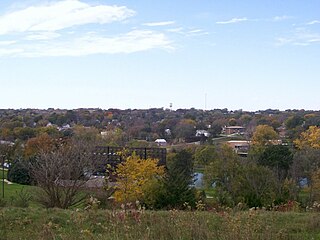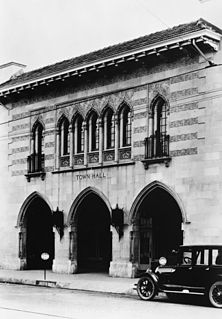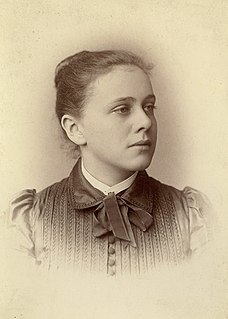
Council Bluffs is a city in and the county seat of Pottawattamie County, Iowa, United States. The city is the most populous in Southwest Iowa, and is a primary city of the Omaha-Council Bluffs Metropolitan Area. It is located on the east bank of the Missouri River, across from the city of Omaha, Nebraska. Council Bluffs was known, until at least 1853, as Kanesville. It was the historic starting point of the Mormon Trail. Kanesville is also the northernmost anchor town of the other emigrant trails, since there was a steam-powered boat to ferry their wagons, and cattle, across the Missouri River. In 1869, the first transcontinental railroad to California was connected to the existing U.S. rail network at Council Bluffs.

Glenwood is a city in, and the county seat of, Mills County, Iowa, United States. The population was 5,269 in the 2010 census, a decline from 5,358 in 2000.

Jules Jacques Benois Benedict was one of the most prominent architects in Colorado history, whose works include a number of well-known landmarks and buildings listed on the National Register of Historic Places.

The New Amsterdam Historic District is a historic district located in Detroit, Michigan. Buildings in this district are on or near three sequential east-west streets on the two blocks between Woodward Avenue and Second Avenue. It was listed on the National Register of Historic Places in 2001.

Amelia Jenks Bloomer was an American women's rights and temperance advocate. Even though she did not create the women's clothing reform style known as bloomers, her name became associated with it because of her early and strong advocacy. In her work with The Lily, she became the first woman to own, operate and edit a newspaper for women.

St. Peter's Catholic Church is a parish of the Diocese of Des Moines. The church is located in Council Bluffs, Iowa, United States. It was listed on the National Register of Historic Places in 1992 as St. Peter's Church and Rectory.

College Square Historic District is a nationally recognized historic district located on a bluff north of downtown Davenport, Iowa, United States. It was listed on the National Register of Historic Places in 1983. The district derives it name from two different colleges that were located here in the 19th century.

George Anthony Berlinghof was a German-born architect who designed a number of important buildings in Lincoln and other cities in Nebraska. Some of his surviving works are listed on the National Register of Historic Places.

B'nai Israel Synagogue is a synagogue in Council Bluffs, Iowa, United States. It is listed on the National Register of Historic Places by its original name Chevra B'nai Yisroel Synagogue in 2007.

The Bennett Building, also known as the Ervin Building is an historic building located in downtown Council Bluffs, Iowa, United States. The previous building to occupy this property was a Woolworth's that was destroyed in a fire in 1922. The Bennett Building Corporation was formed in 1923 to build an office building that was designed to attract medical professionals. The seven-story, brick, Early Commercial structure was designed by local architectural firm Jensen and Larson, and the Omaha firm of McDonald and McDonald served as the supervising architects. E. A. Wickham and Company of Council Bluffs was the contractor.

Edward Hammatt was an architect in the United States. He designed several notable buildings that are listed on the National Register of Historic Places.

John James Huddart (1856–1930), known usually as John J. Huddart, was a British born and trained architect who practised out of Denver, Colorado in the United States. At the end of the Nineteenth century he was one of Denver's leading architects, known for his work on public buildings and as a courthouse architect. His practice lasted from 1882 to 1930 and commissions included Charles Boettcher House in Denver, Colorado's Fort Morgan State Armory, Denver's Filbeck Building, and six of Colorado's county courthouses.

Anne Evans was an American arts patron. She devoted her life to the founding and support of some of Colorado's largest cultural institutions, including the Denver Art Museum, the Central City Opera, and the Denver Public Library. She had decades of experience in leadership positions, particularly in the field of art. She was also a leader of a conservation effort and a fundraiser during World War I.
Robert Earl Langdon Jr. was an American architect based in Los Angeles, California. With Ernest C. Wilson Jr., he designed 27 office buildings along Wilshire Boulevard as well as the Getty Villa in the Pacific Palisades and the Bank of America Building in Beverly Hills. He was the President of the Pasadena chapter of the American Institute of Architects.

The Martin Hughes House is a historic building located in Council Bluffs, Iowa, United States. It is an eclectic combination of Gothic Revival and Queen Anne architectural elements, with influences from the Neoclassical and the Stick styles. The two-story brick structure follows an irregular plan, and features decorative art glass, terra cotta decorative elements, and a wrap-around porch. It was designed by local architect S.E. Maxon. Hughes settled in Council Bluffs in 1856 and worked as a contractor before he operated a brickyard. He also owned large parcels of land in both urban and rural areas. The house was listed on the National Register of Historic Places in 1984.

The Hughes-Irons Motor Company is a historic building located in Council Bluffs, Iowa, United States. Floyd Hughes and George Irons established an automobile sales and service business selling Ford cars and tractors. They built the eastern six bay section of this building in 1917. The two-story brick structure exhibits elements of the Mission Revival style. Irons left the partnership three years later and was replaced by Parmer. Hughes-Parmer added the four western bays in 1923, before the business split into two different companies. Parmer maintained the Ford dealership in the original building and Hughes opened a Chevrolet dealership in the addition. Parmer was replaced by the Atlantic Auto Company in 1930. They were the first in a long line of automobile repair shops and dealerships that occupied the original section of the building. Hughes remained in the addition until 1979, although they expanded into the neighboring building to the west in 1944. Restoration of the building began in 2008, reversing the alterations done to its main facade. The local chamber of commerce occupies the main floor, and the second floor was converted into apartments. J. Chris Jensen was the architect, and the building was listed on the National Register of Historic Places in 2011.

The YMCA Building is a historic building located in Council Bluffs, Iowa, United States. Construction of the building was partially funded by railroad magnet Grenville M. Dodge. The front section, designed by local architect Frederic E. Cox, was completed in 1909. The pool/gymnasium addition in the rear of the building was designed by J. Chris Jensen, another local architect, and completed in 1931. The front section is four stories tall and exhibits elements of the Colonial Revival and Federal styles. The fourth floor was renovated in 1931 and the shed dormers may have been added at that time. The rear addition is architecturally sympathetic to the original section of the building. The Union Pacific Railroad bought the building in 1929 so the facilities would be available for the men who worked on the railroad during the Great Depression. The local YMCA took over ownership again in 1955. The building was listed on the National Register of Historic Places in 1979.

The Park/Glen Avenues Historic District is a nationally recognized historic district located in Council Bluffs, Iowa, United States. It was listed on the National Register of Historic Places in 2010. At the time of its nomination the district consisted of 228 resources, including 179 contributing buildings, one contributing site, five contributing structures, three contributing objects, and 43 non-contributing buildings. The district is a stylish residential neighborhood that developed between 1857 and 1942 with most of the houses built between 1880 and 1930. It was home to the area's "prosperous, second generation merchants, railroad and real estate financiers, and professionals." Several houses have been attributed to architects, including Perley Hale from Chicago, and local architects J. Chris Jensen, and John C. and Winfield S. Woodward. The Lysander Tulleys House (1877) and the Thomas E. Cavin House (1887) are individually listed on the National Register of Historic Places. A non-residential building in the district is the Glendale Reservoir Pumping Station (1942).
Anne Evans Mountain Home is a cabin that was built near Evergreen, Colorado by Anne Evans on the Evans–Elbert Ranch with a view of the Rocky Mountains. It is located in at an elevation of about 8,200 feet the Upper Bear Creek watershed in eastern Clear Creek County, Colorado. Anne Evans chose a location on a hill with views of Mount Evans, named for her father in 1895.

Evans–Elbert Ranch, also called the Elbert-Austin Ranch, was built as a 300-acre family retreat and ranch in Upper Bear Creek near Evergreen in Clear Creek County, Colorado by John Evans, Colorado's second territorial governor. Covering most of Corral Creek, Metz, and Vance valleys, it was a mountain cattle ranch.


















